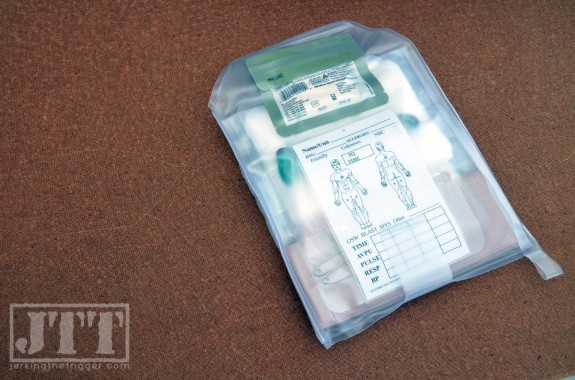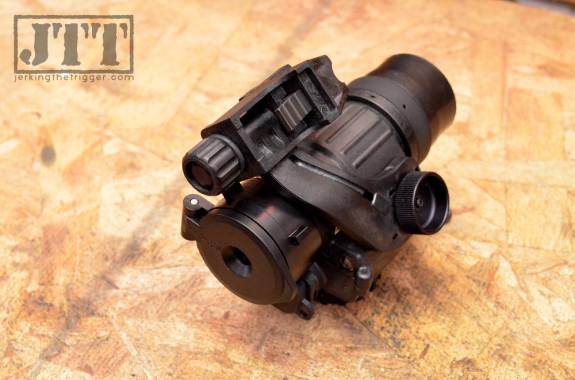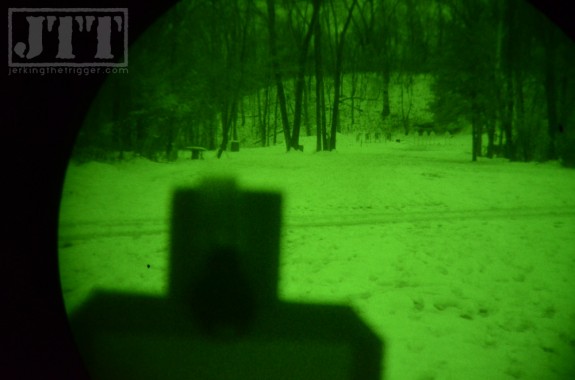The Sons Trauma Kit from Phokus Research Group is a trauma kit that is designed to be carried behind your plates in your plate carrier (PC). This is a massive departure from the way that trauma kits are typically carried which has understandably drawn some skepticism. Certainly, the Sons Trauma Kit may not be for everyone but, in my time with it, I think the audience for this kit may be wider than most people think.

Overview
The Sons Trauma Kit is a simple and well executed concept. It is a trauma kit that is made to be carried behind the plates in your plate carrier and its entire form factor is built around that end goal. A kit intended to be carried in this manner must be extremely thin to fit the plate pocket with the plate and extremely water resistant to protect against sweat and rain. To accomplish this, Phokus Research Group created a durable medical-grade vinyl case that is shaped like a ballistic plate or soft armor insert.

The kit’s contents vary based on which version is chosen. I received the Deployment Configuration which contains the following:
- QuikClot Combat Gauze x1
- 4″ Z-Fold Gauze Bandage x2
- 14G Needle x1
- Occlusive Dressing x2
- NPA w/ 550 x1
- 3″ Elastic Bandage x1
- 2″ Safety Pins x2
- Nitrile Gloves x1
- Casualty Card x1
All of the above items are packed in such a way that the entire kit is never thicker than about ¾” which is pretty darn amazing. It is also notable that the items are packed in such a way that when the kit is opened, nearly everything in the kit is available without digging. Items are placed in an order the represents the order that they will likely be used.
Observations from Use
Much of the skepticism of this kit is surrounding its placement. People will wonder if it will be accessible enough and how someone else will know where it is located should they need to render aid. Those are all good questions and, while I will try to tackle some of them from my experience with the kit, the simplest and best answer is probably… It depends.
The question of whether it will be easily accessible will rely completely on how your plate carrier’s plate pockets are accessed and whether or not you train to access the kit. I placed the Sons Trauma Kit in a number of plate carriers that I had on hand and the only ones that I consider to be unusable with the kit were those with top loading plate pockets or those with complex closure systems. The plate carriers tested include the Mayflower R&C APC, Velocity Systems Light Weight Plate Carrier, Diamondback Tactical FAPC, Shellback Tactical Banshee, SO Tech Viper, and a few others. It really just doesn’t take long to peel open the hook and loop flap found at the bottom of the plate pocket on most PCs. There is an element of common sense at play here. If your PC makes it difficult to remove the plates while you are wearing it, it will be difficult to access the Sons Trauma Kit as well.

It should be noted that placing a surface mount IFAK comes with its own accessibility issues. The front of a PC is usually dedicated to carrying magazines and is probably the last place that you want to add more bulk. Mounting an IFAK on the side of a PC can reduce accessibility, mobility, and impede the draw stroke. Mounting an IFAK on the rear of the PC is common but it will be difficult or impossible for the wearer to access. When viewed through this context, the Sons Trauma Kit may actually solve accessibility problems rather than create them.
The question of how someone else will know where to find your IFAK is a little more involved. I do not have any military or LE experience but I suspect that in those settings it would be typical to set up some sort of SOP that detailed the location of the trauma kit so that all parties knew to check the plate pocket. For those who are using these kits outside of military and LE circles, I would suggest informing those that you shoot with where your Sons Trauma Kit is located and if you have regular shooting partners you may even want to rehearse accessing the kit. This issue is probably the most important factor for you to weigh when deciding whether the Sons Trauma Kit is right for you.
While I certainly wouldn’t blame anyone for reading the above and determining that a traditional surface mounted trauma kit is right for them, there are situations in which the Sons Trauma Kit really solves a problem. The most glaring of which is where do you place a trauma kit on a completely slick concealment plate carrier? The answer used to be “you don’t” but the Sons Trauma Kit can easily be carried inside a concealment carrier while adding minimal additional bulk.
The Sons Trauma Kit’s thin form factor also makes it ideal for applications other than plate pocket carry. For instance, it will easily fit the hydration pouch or laptop sleeve found in many backpacks or brief cases. While most IFAKs are tightly packed cubes that end up at the bottom of your pack, the Sons Trauma Kit can stand vertically in a pack, ready to be accessed, and taking up almost no space at all. It even fit in a laptop sleeve along with the laptop.

I also found several other useful applications. It fits the tight slip pockets found on the back of many car seats. It can be tucked easily between seats in your vehicle. Its slim form makes it easy to tuck into soft or hard carbine cases. Basically, this kit is thin enough to go a lot of places that a typical IFAK can’t go.
It seems to me that the Sons Trauma Kit could be a key piece in a layered approach to load carriage. For instance, I use my belt as my baseline for load carriage. It is set up to be self-contained and its suits me well as a regular guy who doesn’t need to carry much. The belt is the location of my fastest reloads, a few key pieces of range admin gear, and a basic trauma kit. The next piece to the layered approach would be a chest rig or plate carrier. They are only used when necessary and I generally don’t carry much on them. The Sons Trauma Kit could be placed in my PC so that should I need a second trauma kit or I find myself without my belt for some reason; I am not without a trauma kit.

Wrap Up
The Sons Trauma Kit is just about ideal for me for use in a backpack or as a backup to a more traditional, surface mounted kit located on my belt. It has become irreplaceable for me in those roles. Every style of IFAK and every possible mounting location comes with potential issues. The Sons Trauma Kit is no different in that regard. As with any piece of gear, all factors must be weighed to determine if it is right for you.
Check out the Sons Trauma Kit at Phokus Research Group.



















